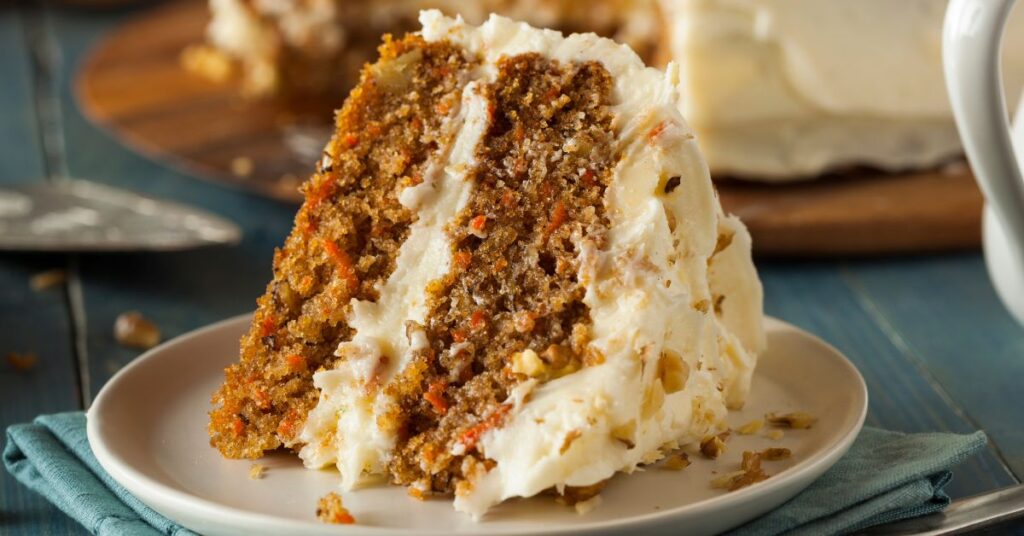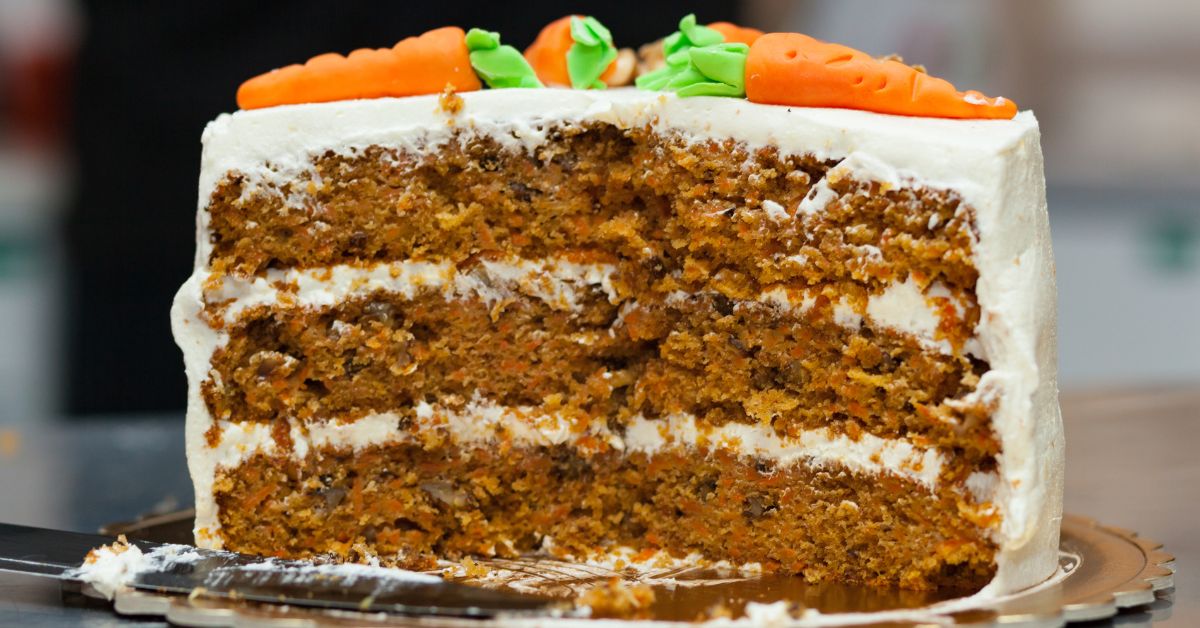Carrot cake, a timeless classic in the world of desserts, has long captivated the hearts of food enthusiasts worldwide. Its unique blend of sweet and spicy flavors, coupled with a moist, dense texture, makes it a standout among cakes. This beloved treat, often adorned with rich cream cheese frosting, has evolved from a simple, wholesome recipe to a gourmet delight, gracing the menus of high-end bakeries and home kitchens alike.
In this comprehensive guide, we delve into the secrets behind creating the ultimate carrot cake. Whether you’re a seasoned baker or a curious novice, our aim is to equip you with not just a recipe, but a blueprint for crafting a carrot cake that’s to die for. From selecting the perfect ingredients to mastering the art of baking, we’ll provide you with all the tips and tricks you need to elevate this classic dessert to new heights. Prepare to embark on a culinary journey that promises to transform your carrot cake experience.
Key Ingredients for the Perfect Carrot Cake
Creating a carrot cake that’s truly to die for requires a harmonious blend of ingredients, each playing a pivotal role in flavor and texture. Here’s a detailed breakdown of the key components:
- Carrots: The star of the show, carrots add natural sweetness, moisture, and a subtle earthy flavor. Grated finely, they blend seamlessly into the batter, ensuring every bite is moist and flavorful.
- Flour: All-purpose flour forms the cake’s structure. It’s the canvas that holds together the myriad of flavors and textures. For a lighter cake, some bakers mix in a portion of cake flour.
- Sugar: Granulated sugar is essential for sweetness and helps in the caramelization process, giving the cake a beautiful golden hue. Brown sugar can be added for a deeper, molasses-like flavor.
- Eggs: Eggs bind the ingredients together and contribute to the cake’s richness and texture. They also help the cake rise during baking.
- Oil: Vegetable oil is preferred for its neutral flavor. It keeps the cake incredibly moist, more so than butter. Some recipes opt for coconut or canola oil as alternatives.
- Baking Powder & Baking Soda: These leavening agents are crucial for a light and fluffy texture. Baking soda also reacts with the acidic components (like brown sugar or pineapple) to enhance the rise.
- Spices: Cinnamon is the most common spice used, adding warmth and depth. Nutmeg, ginger, and cloves are also popular for an extra kick of spice.
- Vanilla Extract: A dash of vanilla extract enhances the overall flavor profile without overpowering the other ingredients.
- Nuts: Chopped walnuts or pecans add a delightful crunch and nutty flavor. They can be mixed into the batter or sprinkled on top for added texture.
- Pineapple: Crushed pineapple is a secret ingredient in many recipes. It adds sweetness and moisture, contributing to the cake’s tender crumb.
- Coconut: Shredded coconut provides a chewy texture and tropical flavor. It’s an optional ingredient but can add an interesting twist to the traditional recipe.
- Raisins: These add little bursts of sweetness and a chewy texture. Golden raisins are a popular choice, but regular raisins work just as well.
Each ingredient in a carrot cake plays a specific role in creating a harmonious balance of flavors and textures. By understanding the purpose of each component, you can tweak the recipe to suit your taste preferences and achieve that perfect slice of carrot cake bliss.
Step-by-Step Recipe Guide: Making “To Die For Carrot Cake”
Embark on the journey to create the most delectable carrot cake with this detailed guide. Each step is crucial, so follow closely for the best results.
Ingredients Preparation
- Carrots: Grate approximately 2 cups of carrots. Use fresh carrots for better moisture and sweetness.
- Dry Ingredients: Sift together 2 cups of all-purpose flour, 1 teaspoon of baking powder, 1 teaspoon of baking soda, 1/2 teaspoon of salt, and 2 teaspoons of ground cinnamon. Add a pinch of nutmeg and ginger for extra flavor.
- Wet Ingredients: In a separate bowl, whisk together 4 eggs, 1 cup of vegetable oil, 2 cups of granulated sugar, and 2 teaspoons of vanilla extract until well combined.
Mixing the Batter
- Combine Dry and Wet Ingredients: Gradually add the dry ingredients to the wet mixture, stirring until just combined. Avoid overmixing to keep the cake tender.
- Fold in Carrots and Extras: Gently fold in the grated carrots. Optionally, add 1 cup of crushed pineapple (drained), 1/2 cup of chopped nuts, and 1/2 cup of raisins or shredded coconut for added texture and flavor.
Baking the Cake
- Prepare Pans: Grease and flour two 9-inch cake pans. You can also line them with parchment paper for easy removal.
- Bake: Divide the batter evenly between the pans. Bake in a preheated oven at 350°F (175°C) for 25-30 minutes, or until a toothpick inserted into the center comes out clean.
- Cooling: Allow the cakes to cool in the pans for about 10 minutes, then transfer to a wire rack to cool completely. This prevents the cakes from becoming soggy.
Assembling the Cake
- Cream Cheese Frosting: While the cakes cool, prepare the frosting by beating together 8 ounces of cream cheese, 1/2 cup of butter, 4 cups of powdered sugar, and 1 teaspoon of vanilla extract until smooth and creamy.
- Layer and Frost: Place one cake layer on a serving plate. Spread a layer of frosting on top. Gently place the second layer over the first and frost the top and sides of the cake.
Tips and Tricks
- Ingredient Temperature: Ensure all ingredients, especially eggs and cream cheese, are at room temperature for a smoother batter and frosting.
- Grating Carrots: Grate the carrots finely for even distribution and a more cohesive texture.
- Baking Evenly: Rotate the pans halfway through baking for even cooking.
- Testing Doneness: The cake is done when it springs back to a light touch and a toothpick comes out clean.
- Cooling: Cooling the cake layers completely before frosting is crucial to prevent the frosting from melting.
Following these steps meticulously will lead you to a carrot cake that’s not just delicious, but also a testament to your baking skills. Enjoy the process and the delightful outcome!
Variations of the Classic Carrot Cake
Carrot cake’s versatility allows it to be adapted to various dietary needs and preferences. Here are some popular variations and how to modify the classic recipe to suit different diets:
1. Gluten-Free Carrot Cake
- Flour Substitute: Replace all-purpose flour with a gluten-free flour blend. Look for a 1:1 baking blend for the best results.
- Binding Agent: Add 1/4 teaspoon of xanthan gum if your gluten-free flour doesn’t include it. This helps in binding the ingredients.
2. Vegan Carrot Cake
- Egg Substitute: Use flax eggs (1 tablespoon ground flaxseed mixed with 3 tablespoons water per egg) or commercial egg replacers.
- Dairy-Free Alternatives: Substitute dairy ingredients with almond or soy milk and vegan butter or coconut oil. For frosting, use vegan cream cheese and vegan butter.
3. Sugar-Free Carrot Cake
- Sweetener Options: Replace granulated sugar with a sugar substitute like erythritol or stevia, suitable for baking. Adjust the quantity based on the sweetness level of the substitute.
- Natural Sweeteners: Consider using applesauce or mashed bananas to add natural sweetness.
4. Nut-Free Carrot Cake
- Omit Nuts: Simply leave out the nuts from the recipe if allergies are a concern.
- Alternative Add-ins: Consider replacing nuts with seeds like pumpkin or sunflower seeds for added texture.
5. Low-Fat Carrot Cake
- Reduce Oil: Cut the amount of oil in half and replace it with unsweetened applesauce to maintain moisture without the fat.
- Light Cream Cheese: Use light cream cheese for the frosting, and consider reducing the amount of butter.
6. Paleo Carrot Cake
- Grain-Free Flour: Use almond flour or coconut flour as a substitute for all-purpose flour.
- Natural Sweeteners: Replace sugar with honey, maple syrup, or coconut sugar.
- Dairy-Free Frosting: Make frosting with coconut cream and maple syrup.
7. Carrot Cake Cupcakes
- Portion Adjustment: Pour the batter into cupcake liners and adjust the baking time (usually around 15-20 minutes).
- Frosting: Pipe the cream cheese frosting on top for a decorative touch.
8. Carrot Cake with a Twist
- Add-ins: Incorporate unique ingredients like orange zest, crystallized ginger, or dried cranberries for a different flavor profile.
- Spice Variation: Experiment with cardamom or allspice for a change in spice flavor.
Each variation requires careful consideration of ingredient substitutions and proportions to maintain the cake’s texture and flavor. Experimenting with these adaptations can lead to delightful new versions of the classic carrot cake, catering to a wide range of tastes and dietary needs.
The Role of Frosting in Carrot Cake
Frosting on a carrot cake does more than just add a decorative touch; it complements and enhances the cake’s flavors and textures. The right frosting can turn a good carrot cake into an extraordinary one.
Types of Frosting for Carrot Cake
- Cream Cheese Frosting: The classic choice, cream cheese frosting offers a tangy contrast to the cake’s sweetness. Its creamy texture pairs perfectly with the moist, dense nature of carrot cake.
- Buttercream Frosting: A lighter option than cream cheese, buttercream frosting can be flavored with vanilla or citrus zest for a refreshing twist.
- Maple Cream Cheese Frosting: Adding maple syrup to traditional cream cheese frosting gives a rich, autumnal flavor that complements the spices in the cake.
- Orange Cream Cheese Frosting: Infusing cream cheese frosting with orange zest or juice adds a fruity, zesty flavor, enhancing the cake’s complexity.
- Cinnamon Frosting: A buttercream or cream cheese frosting with added cinnamon can amplify the warm, spiced notes of the cake.
- Vegan Frosting: For a dairy-free option, use vegan cream cheese and butter substitutes. These can be flavored similarly to traditional frostings.
Recipe for Classic Cream Cheese Frosting
Ingredients:
- 8 ounces cream cheese, softened
- 1/2 cup unsalted butter, softened
- 4 cups powdered sugar, sifted
- 2 teaspoons vanilla extract
Instructions:
- Creaming Base: In a large bowl, beat the softened cream cheese and butter together until smooth and creamy. This forms the base of your frosting.
- Adding Sweetness: Gradually add the powdered sugar to the cream cheese mixture. Beat on low speed initially to incorporate the sugar, then increase to medium, ensuring the mixture is smooth and free of lumps.
- Flavoring: Add the vanilla extract and beat until fully integrated. For a thinner consistency, add a tablespoon of milk or cream.
- Consistency Check: The frosting should be smooth, spreadable, and hold its shape. If it’s too thick, add a bit more milk; if too thin, add more powdered sugar.
- Application: Once the carrot cake has completely cooled, spread the frosting evenly over the top and sides. Use a spatula or piping bag for a more decorative finish.
Tips for Perfect Frosting
- Room Temperature Ingredients: Ensure the cream cheese and butter are at room temperature for a smoother frosting.
- Sifting Powdered Sugar: This prevents lumps in your frosting and guarantees a silky texture.
- Adjusting Thickness: Depending on your preference or the cake’s density, adjust the thickness of the frosting by altering the amount of powdered sugar or liquid.
The frosting not only acts as a luscious complement to carrot cake but also serves as a canvas for your culinary creativity. Whether you stick with the classic cream cheese frosting or experiment with different flavors, the right frosting can elevate your carrot cake to a sublime dessert experience.
Pairing and Serving Suggestions for Carrot Cake
Carrot cake, with its rich flavor and moist texture, pairs wonderfully with a variety of accompaniments. Here are some ideas for serving and creatively presenting this delightful dessert:
Pairing Ideas
- Beverages: Serve with coffee, tea, or a glass of milk. For a more sophisticated pairing, consider a sweet dessert wine or a light, fruity white wine.
- Ice Cream: A scoop of vanilla or cinnamon ice cream complements the warm spices in the cake.
- Fresh Fruits: Fresh berries or a citrus salad can add a refreshing contrast to the rich cake.
- Nuts and Seeds: Sprinkle toasted nuts or seeds on top for added crunch and flavor.
- Sauces: Drizzle caramel or a fruit coulis over the cake for extra sweetness and a touch of elegance.
Presentation and Garnishing Tips
- Layering: For a visually stunning presentation, create a multi-layered cake with frosting between each layer.
- Piping: Use a piping bag to apply frosting for a professional look. Swirls, rosettes, and other designs can add an artistic touch.
- Edible Flowers: Garnish with edible flowers for a pop of color and a touch of sophistication.
- Dusting: A light dusting of powdered sugar or cinnamon can enhance the cake’s appearance.
- Themed Decorations: For special occasions, consider themed decorations like carrot-shaped marzipan or Easter-themed toppers.
Storing and Preserving Carrot Cake
Proper storage is key to maintaining the freshness and moisture of carrot cake. Here are the best practices:
Short-Term Storage
- Room Temperature: Store the unfrosted cake at room temperature for up to two days. Keep it in an airtight container to retain moisture.
- Refrigerated: Frosted carrot cake or in hot and humid conditions should be refrigerated. Cover it with plastic wrap or store in an airtight container. It can last up to a week.
Long-Term Storage
- Freezing: Both frosted and unfrosted carrot cake can be frozen. Wrap the cake tightly in plastic wrap and then in aluminum foil. It can be stored for up to 3 months. Thaw in the refrigerator before serving.
Keeping the Cake Moist
- Airtight Container: Always store the cake in an airtight container to prevent it from drying out.
- Avoid Direct Sunlight: Store the cake away from direct sunlight and heat sources, which can cause it to dry out faster.
By following these serving, presentation, and storage tips, you can ensure that your carrot cake is not only delicious but also visually appealing and fresh for every occasion.
FAQs
Q1: Can I make carrot cake without eggs?
A1: Yes, you can make carrot cake without eggs by using substitutes like applesauce, mashed bananas, or commercial egg replacers. These alternatives help maintain the cake’s moisture and binding.
Q2: How can I tell when my carrot cake is fully baked?
A2: Carrot cake is done when a toothpick inserted into the center comes out clean or with a few moist crumbs. The cake should also spring back when lightly touched.
Q3: Can carrot cake be made in advance?
A3: Absolutely! Carrot cake can be baked ahead of time and stored. Unfrosted cake can be kept at room temperature for a couple of days, while a frosted cake should be refrigerated.
Q4: Is carrot cake healthier than other cakes?
A4: Carrot cake contains carrots and sometimes nuts and fruits, which add nutritional value. However, it’s still a dessert with sugar and fat, so it should be enjoyed in moderation.
Q5: Can I freeze carrot cake?
A5: Yes, carrot cake freezes well. Wrap it tightly in plastic wrap and aluminum foil, and it can be stored in the freezer for up to 3 months.
Q6: What makes carrot cake moist?
A6: The moisture in carrot cake comes from ingredients like grated carrots, oil, and sometimes pineapple or applesauce. These components add both moisture and flavor.
Q7: Can I use whole wheat flour for carrot cake?
A7: Yes, you can use whole wheat flour, but it may make the cake denser. For a lighter texture, try using half whole wheat and half all-purpose flour.

To Die For Carrot Cake
- Total Time: 40 minutes
Ingredients
Instructions
Notes
- Prep Time: 10
- Cook Time: 30
Conclusion
In this comprehensive guide, we’ve journeyed through the delightful world of carrot cake, from its rich history and essential ingredients to expert baking tips and creative variations. Carrot cake is more than just a dessert; it’s a canvas for culinary creativity and a testament to the timeless appeal of simple, wholesome ingredients transformed into something extraordinary.
We encourage you to don your apron, preheat your oven, and embark on the rewarding adventure of baking your own to die for carrot cake. Experiment with the variations, embrace the baking tips, and most importantly, share your delicious creation with friends and family. Remember, every slice of carrot cake carries a story, and now, it’s time to create yours. Happy baking, and we look forward to hearing about your carrot cake experiences!

